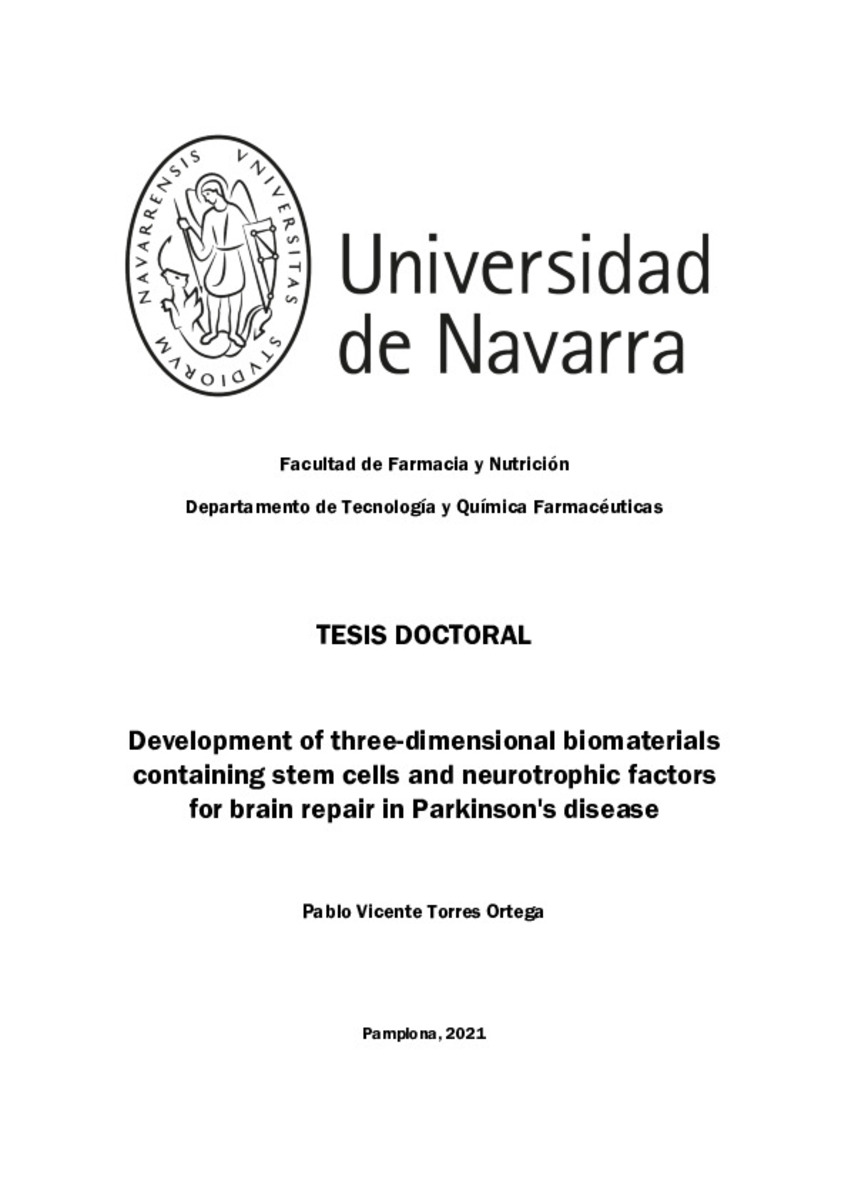Full metadata record
| DC Field | Value | Language |
|---|---|---|
| dc.contributor.advisor | Garbayo, E. (Elisa) | - |
| dc.contributor.advisor | Blanco-Prieto, M.J. (María José) | - |
| dc.creator | Torres-Ortega, P.V. (Pablo Vicente) | - |
| dc.date.accessioned | 2022-03-28T11:12:58Z | - |
| dc.date.available | 2022-03-28T11:12:58Z | - |
| dc.date.issued | 2022-03-28 | - |
| dc.date.submitted | 2021-12-21 | - |
| dc.identifier.citation | TORRES, Pablo Vicente. "Development of three-dimensional biomaterials containing stem cells and neurotrophic factors for brain repair in Parkinson's disease". Garbayo, E. y Blanco, M.J. (dirs.). Tesis doctoral. Universidad de Navarra. Pamplona, 2021. | es_ES |
| dc.identifier.uri | https://hdl.handle.net/10171/63294 | - |
| dc.description.abstract | Therapeutical management of Parkinson's disease (PD) is predominantly focused on controlling motor symptoms and there is no gold standard treatment strategy. Consequently, the medical treatment is tailored to each patient, based on the severity of their symptoms and the adverse effects associated with their medication. Unfortunately, the available therapies provide temporary relief of symptoms but are unable to reverse and halt the disease progression. In the light of this situation, this thesis addresses the development of a PD-modifying therapy where stem cells and the glial cell line-derived neurotrophic factor (hGDNF) are included in a nanoparticle-modified HG. To this end, the following challenges were investigated: 1)The production of clinical-grade therapeutic hGDNF to provide appropriate post-translational modifications and to solve the safety issues related to the immune response (Chapter 1). 2)The assessment of hGDNF potential to modulate the gene expression profile of two cell types with potential for clinical use in PD: Dopaminergic neurons derived from human induced pluripotent stem cells (hiPS-DAns) and human mesenchymal stem cells (hMSCs). (Chapter 2) 3)The development and characterization of an original drug delivery system for brain tissue engineering, where hGDNF and hMSCs are rationally combined into a nanoreinforced HG for their simultaneous administration into the brain (Chapter 2). In the introduction, some of the most encouraging micro- and nanotechnology advances for PD application are summarized and discussed. The experimental section of this thesis is divided into two chapters. The first experimental section presents a novel biphasic temperature cultivation protocol to improve the expression of hGDNF with a high degree of purity and a specific glycosylation pattern. In these experiments, an RNA vector was electroporated into the baby hamster kidney cell line and the electroporated cells were incubated at 37ºC or 33ºC with 5% CO2. A significant improvement in cell survival and hGDNF expression was demonstrated with the increase in the temperature from 33ºC to 37 ºC during the shut-off period . In consonance, this protocol led to the production of almost 3-fold more hGDNF when compared to the previously described methods. Subsequently, in the second chapter, the potential of hGDNF to induce changes in the transcriptome of two cell types with potential for clinical use in PD (hiPS-DAns and hMSCs) was evaluated. The observed effects suggest that this neurotrophic factor can stimulate the expression of genes involved in neuronal plasticity and neurogenesis in both cell types. Next, the neurotrophic factor was successfully encapsulated in polymeric NPs to be subsequently included in a HA-HG modified with adamantane and cyclodextrin. In this section, the mechanical properties of this scaffold were investigated. Then, the neural compatibility of the system was studied on PC12 cells and its compatibility with the hMSCs cell line was explored. Regarding mechanical properties, the developed biomaterial demonstrated shear-thinning and self-healing features. Moreover, the NPs incorporation into the HG allowed a more sustained hGDNF release profile, as well as a significant reduction of drug release at two weeks. Importantly, this scaffold provided an ideal environment for PC12 and hMSCs. In summary, the suitable strength, excellent self-healing properties and good biocompatibility make this HG a good candidate to administer drugs and cells for brain repair applications. Finally, a comprehensive perspective on the different hypotheses set forth in this thesis as well as their scientific contribution to the brain regenerative field is provided in the General Discussion. | es_ES |
| dc.language.iso | eng | es_ES |
| dc.publisher | Universidad de Navarra | es_ES |
| dc.rights | info:eu-repo/semantics/openAccess | * |
| dc.subject | Materias Investigacion::Farmacia::Química farmacéutica | es_ES |
| dc.subject | Parkinson | es_ES |
| dc.subject | Parkinson’s disease (PD) | es_ES |
| dc.subject | Brain repair | es_ES |
| dc.subject | Three-dimensional biomaterials | es_ES |
| dc.title | Development of three-dimensional biomaterials containing stem cells and neurotrophic factors for brain repair in Parkinson's disease | es_ES |
| dc.type | info:eu-repo/semantics/doctoralThesis | es_ES |
| dc.identifier.doi | 10.15581/10171/63294 | - |
Files in This Item:
Statistics and impact
Items in Dadun are protected by copyright, with all rights reserved, unless otherwise indicated.






